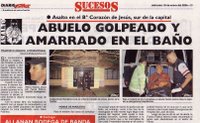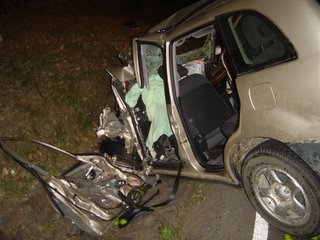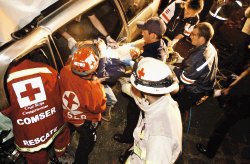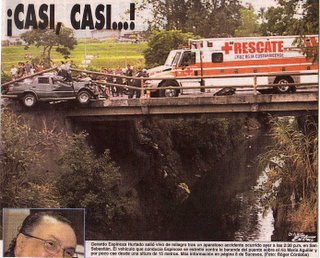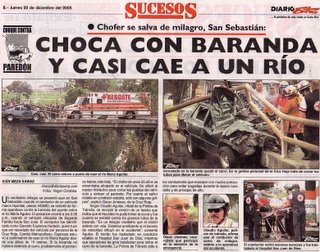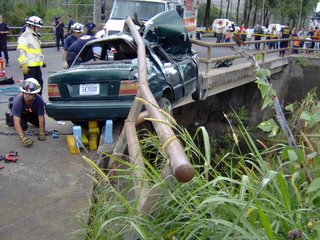Miércoles 28 de Diciembre:
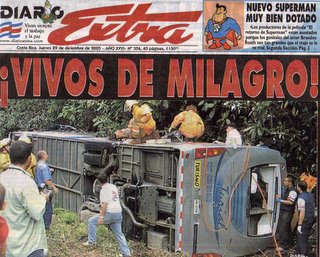
Normalmente, las unidades del comité metropolitano son despachadas a sectores en las cercanías de su zona de atención. Tiene que ser un incidente muy grande o importante para que salgan de dicha zona. Este miércoles 28 de diciembre, un bus cargado con 43 turistas extranjeros (la gran mayoría ciudadanos de los Estados Unidos) volcó en Bajo Rodríguez, en San Ramón de Alajuela, zona que está a unas 2 horas de viaje desde la ciudad capital.
Debido a la gran cantidad de pacientes, al pequeño número de ambulancias disponibles en la zona, y a la también poca cantidad de equipos de rescate, recibimos el despacho de desplazar las unidades 05 y 02 al lugar.
El viaje no iba a ser fácil, especialmente porque en un gran tramo del camino viajaba en sentido contrario la Vuelta Ciclística. Dichosamente, un motorizado de la fuerza pública y varios de la policía de tránsito nos escoltaron, alertando así a los ciclistas que venían (y posteriormente a los camiones) para que se orillaran oportunamente.
El viaje es sí tardó cerca de 1 hora 15 minutos. Al llegar a la escena, la primera impresión fue una de desorden. Mi compañera, Lizette, preguntó a uno de los socorristas ya presentes en la escena quién era el mando, y no supo contestar. Dentro del autobus solamente había una persona, una mujer que se mantenía prensada, y los bomberos estaban aún intentando sacarla. Nuestro camión de rescate, el 02, aún no había llegado.
Lizette y yo decidimos entonces retirarnos del bus e ir a evaluar a los pacientes que se encontraban en las cercanías, muchos de ellos con traumar abierto y muy desorientados. La gran problemática era que la mayoría de estos pasajeros era ciudadanos estadounidenses que no hablaban español, por lo que la evaluación de su estado era muy difícil. En la escena habíamos alrededor de 4 o 5 personas que sabíamos comunicarnos en inglés, por lo que prontamente iniciamos el tratamiento a más de 30 heridos. Ya las unidades que habían llegado al lugar anteriormente habían bastante trabajo (inmovilizaciones, control de sangrados, etc...), pero debido a la barrera idiomática fue necesario continuar con el trabajo de evaluación y tratamiento una vez que fue posible comunicarse con los pacientes.
Finalmente, después de unos 50 minutos de mantenerla prensada, los bomberos lograron liberar a la mujer que aún estaba dentro de autobús, la cual aparentemente presentada un importante trauma abdominal, y posible fractura de base de cráneo.
Los heridos fueron movilizados en ambulancias de la zona rumbo al hospital de San Ramón, donde se montó un puesto de triage para evaluar a los pacientes y decidir la atención intra-hospitalaria que requerían. Se coordinó el helicóptero de Aerodiva para evacuar por vía aérea a los pacientes más graves, los cuales fueron trasladados por ambulancias de la Cruz Roja hasta donde estaba el helicóptero, propiamente en la plaza de San Ramón.
El hecho fue noticia de gran atención a nivel nacional.
Album de Fotos
http://public.fotki.com/murdockcrc/vuelco_bus_turismo/
December, Wednesday 28th 2005:
Normally, units of the Metropolitan Comittee are dispatched to areas close to the perimeter of the designated work area. There has to be a very big or important incident so that the units are movilized to areas farther away. This Wednesday 28th, a bus loaded with 43 foreign passengers (mostly American citizens) rolled over in Bajo Rodríguez, San Ramón de Alajuela, a place that's about 2 hours-drive from the capital city. Because of the huge amount of injured people, and the reduced number of available ambulances at the zone, we were dispatched in units 05 and 02.
The trip was not going to be easy, not only because of the long journey, but because there was a big portion of the road that was closed because of the Costa Rican Bicycle Tour, whose cyclists were on the opposite direction on the same road we were supposed to go. Luckily, a motorized police officer and some transit police units escorted us during the trip, warning the cyclists and the truck drivers to step aside before our ambulance went through.
It took us 1 hour and 15 minutes to complete the trip. Once at the scene, my first impression was of disorder. There was not an incident command clearly established, and this led to people doing things in an uncoordinated way. My partner, Lizette, asked on of the rescuers who was in charge, and he said he didn't know. Once Capt. Rovira (we came along with us in unit 882) took command, things started work a little bit better. Inside the bus a woman remained trapped, and the firemen from San Ramón were working on to free her. Our rescue truck, 02, hadn´t arrived yet.
So Lizette and I decided to get away from the bus and evaluate the rest of the nearby patients, many of them with open traumas and very confused. The big problem there was that most of the patients did not speak Spanish, and many of the paramedics and rescuers did not speak English, so evaluating them was pretty difficult. Only 4 people and me spoke English, so wer starting evaluating the patients and treating them. The personnel that arrived previously had already provided some treatment (immobilizations, splinting, hemorrhage control), but because of the language-barrier they were unable to conduct a complete evaluation of each patient. Nearly 30 injured passengers were given pre-hospital treatment.
Finally, after 50 minutes being trapped, the firemen were able to free the woman who was trapped inside the bus, who presumably had an important closed abdominal trauma and a base cranial fracture.
The injured were mobilized in local zone ambulances to the San Ramón Hospital, were they had set up a triage post to rapidly evaluate what type of intra-hospital treatment each patient needed. The chopper from Aerodiva was coordinated to arrive at San Ramón so the most critically injured patients were evacuated to capital Hospital by air.
One particular anecdote I can tell about this incident is this patient that I see coming right at me, clearly disoriented and with difficulty walking. I told him "Sir, may I conduct a rapid check to you" to what he answered positively. But to my confusion, he continued past me and ignored what I had just told him. Angry about his attitude, I told him loudly "Sir, could you please pay attention!". He heard (finally), turned around, looked at me straight to my eyes and said "it is difficult for me, my wife is in that ambulance and my son in that other one." So then I realized he was not ignoring me on purpose, but rather looking after his loved ones, though not looking after himself. I told him that I understood his situation, but we needed to check him out and assess his condition. He finally agreed and we had to immobilize this neck and spine.
Another one was particularly anxious. He was trying to say something but noone understood because of the language-barrier. I approach this fellow and asked him what was the matter. A paramedic nearby told me that he had an important cervical trauma and a limb fracture, and had to be taken quickly to the hospital. I started talking to him and told him how important it was for us to transport him to the hospital. We said he knew, but he wasn't going anywhere. When I asked him why, he said, between tears, that it was his wife the one left trapped inside the bus. It was not easy for me to convince with of the neccessity to transport him. I told him that it was no use to wait for his wife if that meant deteriorating his own health, and that were were going to coordinate so that his wife would be taken to the same hospital facility as him. Once I told him that, he agreed to be taken to the ambulance for transport.
Photo Album
http://public.fotki.com/murdockcrc/vuelco_bus_turismo/
05:
Luis Ángel
Liz
Kondor
02:
Nando
Jim
Bermúdez
Torres
882:
Capt. Rovira
 Miércoles 25 de Enero, 2006:
Miércoles 25 de Enero, 2006:

